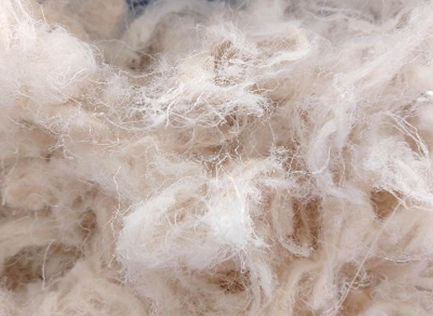Development of Sustainable Yarns from an Innovative Combination of European Hemp and Pure Recycled Wool
DOI:
https://doi.org/10.25367/cdatp.2024.5.p56-65Abstract
Currently, only a very small percentage of textiles is recycled; the majority is incinerated or sent to landfill. Due to the advancing climate change, the responsible use of available resources is becoming more important than ever. The process of rethinking begins in product development with the selection of raw materials. In the project “CannaReWool” (EFRE-0802000), German hemp and pure recycled wool are blended, spun and knitted into fabrics. The aim of the project is to produce knitted fabrics that can be recycled in a closed loop due to their novel combination of materials. The aim is to determine the most suitable settings and spinning components to ensure a stable rotor spinning process. The evaluation is based on the number of yarn breaks per rotor hour. The trials are carried out on the Schlafhorst Autocoro 480 rotor spinning machine. As both fibers, hemp and recycled wool, are very short and lack fiber to fiber cohesion, it becomes apparent that no settings can be found that give the spinning process sufficient stability. The results of the Uster Tester 6 and the Textechno Statimat tests show that the yarns contain a high amount of imperfections and the tensile strength values are low. Nonetheless the yarn is successfully knitted into fabrics on a Stoll ADF flat knitting machine. In the course of the project, the knitting trials will be continued and areas of application for the fabrics will be determined.
References
European Statistical Office. Generation of waste by waste category, hazardousness and NACE Rev. 2 activity, 2016.
Bundesverband Sekundärrohstoffe und Entsorgung e. V. Zahlen zur Sammlung und Verwendung von Altkleidern in Deutschland. https://www.bvse.de/themen/geschichte-des-textilrecycling/zahlen-zur-sammlung-und-verwendung-von-altkleidern.html (accessed October 7, 2022).
Ellen MacArthur Foundation. A new textiles economy: Redesigning fashion's future, 2017.
World Economic Forum; Boston Consulting Group. Net-Zero Challenge: The supply chain opportunity, 2021.
Umweltbundesamt. KLEIDER mit HAKEN: Fallstudie zur globalen Umweltinanspruchnahme durch die Herstellung unserer Kleidung, 2021.
Ferrigno, S.; Guadagnini, R.; Tyrell, K. Is cotton conquering its chemical addiction? A review of pesticide use in global cotton production; Pesticide Action Network UK, The Green Hub, Brighton, UK, 2017.
Cherrett, N.; Barrett, J.; Clemett, A.; Chadwick, M.; Chadwick, M. J. Ecological Footprint and Water Analysis of Cotton, Hemp and Polyester. Stockholm Environment Institute, Stockholm, Sweden, 2005.
Drastig, K.; Flemming, I.; Gusovius, H.-J.; Herppich, W.B. Study of Water Productivity of Industrial Hemp under Hot and Dry Conditions in Brandenburg (Germany) in the Year 2018. Water 2020, 12, 2982.
2019 Hemp Annual Report: China, 02/2020.
Bundesanstalt für Landwirtschaft und Ernährung. Pressemitteilungen – Nutzhanfanbau 2021: Anzahl der Betriebe und Fläche weiter gewachsen. https://www.ble.de/SharedDocs/Pressemitteilungen/DE/2021/211001_Nutzhanfanbau.html (accessed March 22, 2023).
Schmücker; Rebekka. Hanf als Zwischenfrucht – Winterhanf, Versuchs- und Bildungszentrum Landwirtschaft Haus Düsse, Bad Sassendorf, Germany, 2019.
Blackburn, R., Ed. Biodegradable and Sustainable Fibers; Woodhead Publishing Limited, Cambridge, 2005.
Hych, O.; Zakora, O.; Rastorhuieva, M.; Zilinskyi, A. Trial using of ultrasonic cavitation in cottonization processes of hemp fibers. ScienceRise 2021, 4, 24-31.
Naumenko, V. Physikalische Fasereigenschaften von Hanf (Cannabis sativa L.) in Abhängigkeit von Bestandesentwicklung, Strohmanagement, Röste und Faseraufschluss. Dissertation thesis, Martin-Luther-Universität, February 20, 2006.
Schlafhorst, Saurer Germany GmbH & Co. KG. Belcoro Spinnmittel und Autocoro Ersatzteile.
Kozlowski, R.M.; Mackiewicz-Talarczyk, M., Eds. Handbook of Natural Fibers: Volume 2: Processing and Applications; Woodhead Publishing: Duxford, Cambridge, Kidlington, 2020.
Rieter Machine Works Ltd., Ed. The Rieter Manual of Spinning: Volume 5 – Rotor Spinning; Winterthur, Switzerland, 2016.
Rieter Machine Works Ltd., Ed. The Rieter Manual of Spinning: Volume 1 – Technology of Short-staple Spinning; Winterthur, Switzerland, 2016.
Autocoro 9. Leading technology – the next generation. Schlafhorst, Übach-Palenberg, Germany 2015.

Downloads
Published
How to Cite
Issue
Section
License
Copyright (c) 2024 Lisa Streitenberger, Prisca Holderied, Julia Klausmann, Thomas Mutschler, Daniel Pattberg, Thomas Weide, Marcus O. Weber

This work is licensed under a Creative Commons Attribution 4.0 International License.





